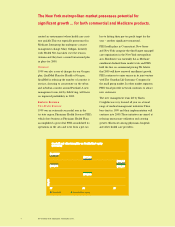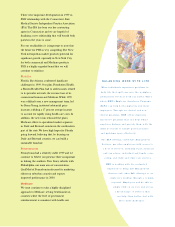Health Net 1999 Annual Report Download - page 19
Download and view the complete annual report
Please find page 19 of the 1999 Health Net annual report below. You can navigate through the pages in the report by either clicking on the pages listed below, or by using the keyword search tool below to find specific information within the annual report.
Revenues and Health Care Costs
The Company’s total revenues increased by $71.8 million or
1% for the year ended December 31, 1999 as compared to
1998.The decrease in Health Plan Services segment revenues
of $93.1 million or 1% was offset by an increase in Govern-
ment Contracts/ Specialty Services segment revenues of
$118.6 million or 8%.The decrease in Health Plan Services
segment revenues for the year was due to enrollment declines
resulting from divestitures of non-core plans and planned
membership attrition from pricing actions. Enrollment in the
Company’s health plans declined by approximately 5% or
228,000 members of which 71,000 members were from
divested health plans for the year ended December 31, 1999
as compared to 1998.This membership decrease was offset by
premium rate increases as described below.The increase in
Government Contracts/ Specialty Services segment revenues
was due primarily to increases in TR ICAR E revenues of 11%
and continued growth in the Company’s behavioral health
network, including TR ICAR E affiliated business, of 21%.
The Company’s commercial product lines are profit-
able. Premium rate increases of 8% in the commercial line
of products contributed to revenue increases for the year
ended December 31, 1999 as compared to the prior year.
These premium rate increases were partially offset by a 9%
enrollment decrease from the divestitures of non-core plans
and planned membership attrition from pricing actions,
resulting in an increase in commercial premium revenue.
The Company’s Medicare product lines are profitable.
Medicare premium rates have increased 7%, but enrollment
has declined by 12% due to the Company exiting certain
unprofitable counties, primarily in the Northeast health
plans.The Company’s Medicaid product lines are profitable.
Medicaid premium rates have increased in all markets aver-
aging about 5%. Medicaid enrollment has increased in all
divisions resulting in a 16% increase in membership.
Also contributing to the increase in total revenues was
a $58.3 million net gain on sale of businesses and proper-
ties. During 1999, the Company completed nine divestiture
transactions, essentially completing its divestitures program
of non-core businesses. See Note 3 - Acquisitions and Dis-
positions to the consolidated financial statements.
The Company’s total revenues increased by $1.6 billion
or 23% for the year ended December 31, 1998 as compared
to 1997. Growth in the Health Plan Services segment rev-
enues of $1.6 billion or 30% for the year was due primarily
to the acquisitions that occurred in the fourth quarter of
1997, including Physicians Health Services, Inc. (“PHS”),
FOHP, Inc. (“FOHP”) and PACC HMO, Inc. and PACC
Health Plans, Inc. (collectively “PACC”).These acquisitions
collectively accounted for approximately $1.4 billion of the
increase. Excluding these acquisitions, health plan revenues
increased by approximately $199 million or 4% for the year
ended December 31, 1998.The growth from existing health
plan businesses was due to increases in premium rates averag-
ing 4% on a per member per month basis in virtually all
markets which were partially offset by a 2% decrease in aver-
age membership. See the Enrollment Information section of
the previous table for year-end membership information.
Growth in the Government Contracts/ Specialty Services
segment revenues totaled $2.9 million for the year ended
December 31, 1998, primarily due to continued growth in
the Company’s managed behavioral health network.
The overall medical care ratio (“MCR ”) (medical costs
as a percentage of the sum of Health Plan Services and
Government Contracts/ Specialty Services revenues) for the
year ended December 31, 1999 was 81.22% as compared to
82.18% for the year ended December 31, 1998.This resulted
from the 8% premium rate increase which exceeded a 7%
increase in health care costs on a per member per month basis
for the Health Plan Services segment.
The overall MCR for the year ended December 31,
1998 was 82.18% as compared to 79.25% for the year
ended December 31, 1997.This resulted primarily from
increases in health care costs (4% on a per member per
month basis).The increase in health care costs was primar-
ily due to higher pharmacy costs in all divisions, which
increased by 18%.
Health Plan Services costs decreased by $140.5 million
or 2% for the year ended December 31, 1999 as compared
to 1998 primarily as a result of a 5% decrease in enroll-
ment.The Health Plan Services MCR decreased to 84.62%
in 1999 from 85.49% in 1998 due to an increased focus on
medical management.
Health Plan Services costs increased by $1.6 billion or
36% for the year ended December 31, 1998 as compared to
1997 primarily as a result of enrollment increases in the
Northeast Division, Medicaid enrollment growth in the
California Division, and pharmacy cost increases in all divi-
sions.The Health Plans Services MCR increased to 85.49%
in 1998 from 81.54% in 1997 due to higher medical costs
particularly in physician and hospital fee-for-service costs,
increases in pharmacy costs and increased utilization.
The Government Contracts/ Specialty Services MCR
increased slightly to 65.55% for 1999 as compared to
65.48% for 1998.This increase for 1999 was primarily due
to the movement of health care services from military treat-
ment facilities to civilian facilities which resulted in higher
costs than originally specified in the contract.
The Government Contracts/ Specialty Services MCR
decreased to 65.48% for 1998 compared to 70.33% for 1997.
This decrease for 1998 is primarily due to improved health
care and subcontractor performance on the TR ICARE con-
tracts which was partially offset by increased pharmacy costs
and higher health care claim costs on TR ICAR E contracts.
FOUNDATION HEALTH SYSTEMS, INC. 17
























